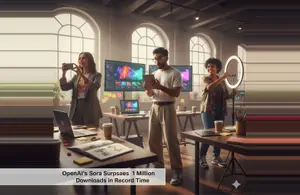- Embedded Sponsorship: U.S. Bank serves as the Tour Championship sponsor within the film, ensuring natural brand integration.
- Bespoke TV Spot: The “Happy As Usual” ad blends golf commentary, celebrity cameos, and banking messaging for a memorable narrative.
- Multi‑Channel Reach: Campaign runs across TV, digital platforms, and Netflix’s ad‑supported plan to engage diverse demographics.
- Humor with Integrity: The bank balances playful tone with trustworthiness by collaborating directly with the film’s creative team.
- Blueprint for Brands: Partnering with popular entertainment properties offers financial brands a way to humanize messaging and expand reach.
From on‑screen logos to a bespoke TV spot, the bank rewrites finance marketing with a playful, cinematic twist.
Rather than inserting a static logo into a single scene, U.S. Bank wove itself through the very fabric of Happy Gilmore 2’s narrative world. As the title sponsor of the film’s fictional “Tour Championship,” the bank’s branding appears on tournament signage, course banners, and the caddy bib worn by the beloved protagonist.
These touches don’t feel like afterthoughts; they emerge organically within the golf‑centric storyline, aligning the bank with the film’s nostalgic tone and lighthearted competition. By occupying this narrative space, U.S. Bank isn’t merely visible; it becomes part of the movie’s cultural moment, inviting audiences to associate the brand with the energy and charm of the sequel.
This integration extended beyond passive placement into an active storytelling role. The bank’s presence underscores key plot points, such as celebratory trophy presentations and locker‑room interviews, transforming routine financial messaging into a backdrop for cinematic humor.
Viewers come away not just recalling a logo, but remembering the moment when the bank helped bankroll a character’s victory dance or when an announcer quipped about financial “par for the course.” Through this approach, U.S. Bank demonstrated that a brand can inhabit a fictional universe deeply enough to feel indispensable to its storytelling.
Crafting the “Happy As Usual” Campaign
Parallel to its on‑screen role, U.S. Bank co‑developed a hero television spot with Netflix, Adam Sandler’s Happy Madison production house, and creative agency Barkley. Titled “Happy As Usual,” the commercial reimagines the bank branch as a makeshift golf commentary booth.
Legendary announcer Verne Lundquist delivers play‑by‑play narration while customers conduct routine banking tasks. In one memorable scene, pro golfer Collin Morikawa—U.S. Bank’s real‑world ambassador—deposits a comically oversized check and breaks into the film’s signature dance. By transplanting cinematic elements into everyday banking, the spot bridges the gap between fiction and reality, reinforcing the idea that financial services can be as engaging and unexpected as blockbuster entertainment.
The creative process itself blurred the lines between marketing and filmmaking. U.S. Bank executives collaborated on set with Happy Madison’s writers and producers to ensure authenticity. Script revisions considered both comedic timing and brand messaging, resulting in a spot that feels like an extension of the movie rather than a disconnected advertisement.
This level of creative investment allowed the bank to embrace humor confidently, knowing that each joke and visual gag would land in tone with audience expectations established by the film.
Reaching Audiences Across Platforms
Understanding that modern viewers consume content across a fragmented media landscape, U.S. Bank deployed its Happy Gilmore 2 campaign across a spectrum of channels. Traditional broadcast networks such as NBC and ESPN carried the “Happy As Usual” spot, ensuring visibility among live sports viewers and general audiences.
Simultaneously, the campaign extended into digital environments—running commercials on YouTube, social videos on Meta and Snapchat, and ads within Netflix’s ad‑supported tier. This layered distribution meant that whether someone tuned in for prime‑time television, scrolled through their social feed, or streamed the sequel itself, they encountered a consistent narrative thread tying U.S. Bank to the film’s playful spirit.
Beyond scheduled airings, the bank amplified engagement through targeted social content featuring behind‑the‑scenes footage and additional cameo appearances by Morikawa. These supplementary assets deepened the storyline, giving fans a glimpse of how the partnership came together and reinforcing the campaign’s authenticity.
By crafting platform‑specific creative—such as vertical‑video snippets for mobile users—the bank maximized impact without diluting the core message. The result was a cohesive, omnichannel experience that met audiences wherever they engaged with media, strengthening recall and fostering brand affinity.
Strategic Insights for Marketers
U.S. Bank’s Happy Gilmore 2 collaboration offers a roadmap for brands seeking to transcend conventional advertising.
- First, embedding a sponsor within a film’s core narrative—rather than relegating it to background decor—yields stronger emotional resonance. When a brand feels integral to the story, audiences internalize its presence as part of the entertainment itself.
- Second, co‑creating purpose‑built content that mirrors cinematic conventions can transform routine messaging into memorable experiences. By adopting storytelling techniques from film—such as character cameos and genre‑consistent humor—marketers can elevate commercials beyond transactional pitches.
- Finally, a holistic media strategy that spans broadcast, streaming, and social platforms ensures that creative investments pay dividends at every touchpoint.
Consistency in tone and visuals across channels reinforces brand identity, while platform‑tailored executions respect the nuances of each audience segment. For financial institutions wary of appearing too serious, U.S. Bank’s campaign proves that strategic humor—grounded in authentic collaboration—can humanize a brand without compromising its core values.
In an era of ad avoidance and second‑screen distractions, such inventive partnerships may well define the future of marketing.
Story-First Advertising
In pushing beyond conventional product placement, U.S. Bank has crafted an advertising model that treats brand exposure as a storytelling opportunity. Happy Gilmore 2 becomes more than a backdrop—it serves as a dynamic stage for the bank’s creative aspirations.
As media fragmentation continues to challenge marketers, this campaign offers a blueprint: embed your brand in moments that matter, co-create with cultural creators, and deliver messages through the power of narrative. In doing so, brands can transcend interruption tactics and become integral characters in consumers’ media experiences.



